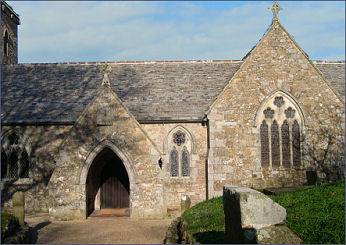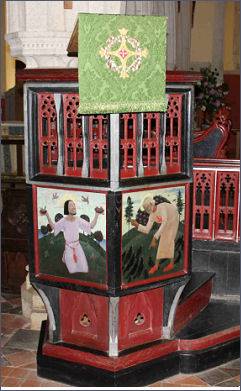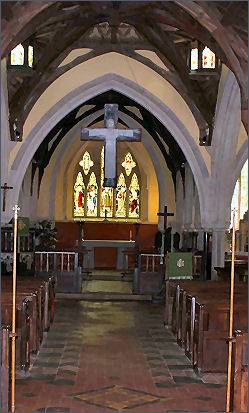St. Hilary
OS Grid ref:- SW 550 312
 The village of St. Hilary, known in Cornish as Gorlynn, lies five miles to the east of the town of Penzance and two miles to the south of stunning Mount's Bay.
The village of St. Hilary, known in Cornish as Gorlynn, lies five miles to the east of the town of Penzance and two miles to the south of stunning Mount's Bay.
The area has many former mines, including Wheal Fortune which extended into the parish of Ludgvan, documentary evidence from 1508 of a mine known as Cog-an-bans (Higher Work) or Goghan Bras (Great Coffin) may relate to this pit. Penberthy Croft Mine, to the north of the parish, was designated a Site of Special Scientific Interest in 1993 and is noted as the most important site in Britain for secondary ore minerals of lead, copper, and arsenic. Trevarno House is the former home of the Wallis mining family.
The small village of granite cottages has a school, a church and a campsite , nearby Goldsithney provides the local pubs and village store.
The St. Hilary Heritage Centre occupies the Old School building which stands beside the village church, the building was restored during 2009-11. The centre documents the rich history of its area and of St Hilary Church. It holds a unique collection of Newlyn-school paintings from the 1920's, formed by the then vicar, Bernard Walke. A series of panels depicts aspects of the history, along with some small artefacts. Many interesting documents are housed in the Centre and informative materials available for purchase.
The Church of St Hilary
 The village church is dedicated to Saint Hilary of Poitiers, a fourth century bishop and is in the Early English style but was rebuilt by the architect William White after a fire in 1853, it still retains its thirteenth century tower.
The village church is dedicated to Saint Hilary of Poitiers, a fourth century bishop and is in the Early English style but was rebuilt by the architect William White after a fire in 1853, it still retains its thirteenth century tower.
 A Roman milestone was discovered in the foundations of the church in 1854, and is now displayed in the south aisle. It bears the inscription-
A Roman milestone was discovered in the foundations of the church in 1854, and is now displayed in the south aisle. It bears the inscription-
'Imp Caes Flav Val Constantino Pio nob Caes divi Constanti Pii F[el] Aug[usti] filio,'
The inscription refers to the Roman emperor Constantine the Great. The churchyard contains both British and Roman crosses.
Bernard "Ber" Walke was made Vicar of St Hilary in 1912; he was the priest from 1913 to 1936. Walke was described as "a monastic looking man" and his dress was unusual; it included a long black cloak and a hat somewhat resembling a sombrero.
Although the medieval St Hilary church was rebuilt in 1853, it sadly lacked interior decoration. The Vicar's wife, Annie Walke and several of the couple's artist friends from the "Lamorna Group" of the Newlyn School were accordingly commissioned to decorate the church with altar pieces, panels and other works. Some of these works depicted the lives of saints from Cornwall.
One of Annie's works for the church was a Joan of Arc painting which is situated just inside the south door of the building. Ernest Procter produced a work that depicts St Mawes, St Kevin and St Neot for the pulpit and a reredos of the Altar of the Dead. Annie, Dod and Ernest Procter, Gladys Hynes, Alethea and Norman Garstin and Harold Knight all made paintings for the sides of the stalls in the church. Phyllis ("Pog") Yglesias made the north wall's crucifix and nearby is Roger Fry's reredos. 12 year old Joan Manning Saunders made the painted pictures for a chancel screen.
Towns and Villages of Cornwall